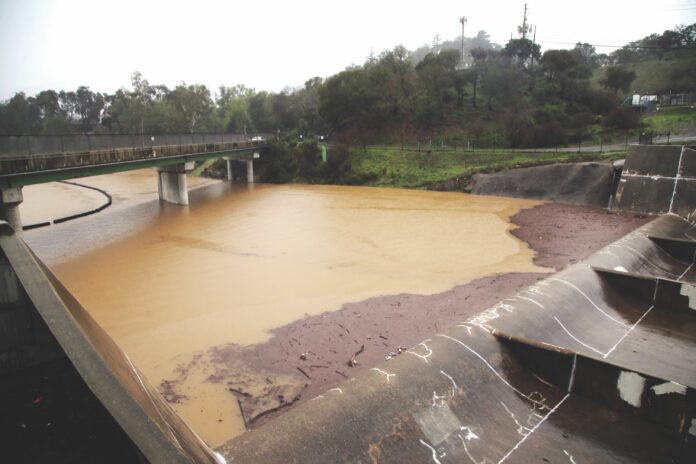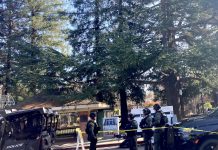
The drought might not be completely done with California, but the state’s residents are now free of the strictest water conservation measures put in place by Gov. Gavin Newsom nearly two years ago.
Standing at a podium in front of a storm-soaked agricultural field in Yolo County on March 24, Newsom stopped short of declaring the end of the punishing three-year drought but said that while he’s not rescinding the statewide drought emergency order, he is eliminating many of its provisions.
“To answer the question ‘Are we out of the drought?’ Mostly but not completely,” Newsom said.
After three months of extremely wet weather that lashed the state with nearly 20 major storms, the Sierra Nevada snowpack is now roughly 228% of average and most reservoirs are at or above their historical averages for this time of year. Lexington Reservoir in Los Gatos stands at 95% of capacity, according to Valley Water data.
In response, Newsom signed an executive order eliminating more than 50 of the 81 drought emergency provisions that he enacted in April 2021, including the 15% statewide voluntary water conservation goal and the requirement that roughly 450 local water agencies enact their own drought emergency plans.
“Today’s announcements from Governor Gavin Newsom and the state’s leadership regarding the drought and increased water supply is welcome news in Santa Clara County,” Valley Water Board Chair John L. Varela said. “Based on these announcements, our staff plans to bring recommendations to our Board of Directors related to the existing water conservation rules for Santa Clara County.”
In June 2021, Valley Water declared a water shortage emergency condition in Santa Clara County and called for water use reduction of 15% compared to 2019. In May 2022, the board adopted a program to enforce restrictions on outdoor water use by residents and businesses.
In September, the board voted to enforce the state’s ban against watering decorative lawns on commercial, industrial and institutional properties. The state’s ban against watering decorative lawns on these properties remains in effect.
“I would like to thank Governor Newsom for his leadership throughout the drought,” Varela said. “We stand in solidarity with the governor in asking our residents to make water conservation a way of life. With climate change, we know droughts will become more frequent and more severe in the future.
“I would also like to thank all our residents, businesses and farmers who took steps during the past three years to reduce their water use. Your actions made a difference in helping us navigate through some record-dry years.”
While the 15% conservation goal was in place, Californians saved roughly 600,000 acre-feet of water, which is enough to supply water to 1.2 million households for a year.
At the same time, the governor noted that the state’s climate is changing and “weather whiplash” is resulting in periods of extremely hot and dry conditions followed by periods of extremely wet conditions, which means water conservation is still key to ensuring reliable long-term water supplies.
Also, the Klamath River Basin in far Northern California and the Colorado River Basin, which supplies water to millions of Southern California residents, remain mired in drought.
“The conditions have radically changed throughout the state, but not enough in places like Klamath and around the Colorado River Basin to call for the end of the drought in California,” Newsom said.
With that in mind, many of the drought rules will remain in effect, including a provision that requires large institutions and businesses to refrain from watering ornamental lawns, as well as a prohibition on using water to clean sidewalks and driveways.
Also, the rules allowing California water managers to more easily release water from reservoirs for the purpose of recharging the state’s severely over-pumped and depleted groundwater basins were not eliminated.
“So this is a good news moment,” said California Natural Resources Secretary Wade Crowfoot, who also attended March 24’s news conference. “Those storms have brought record amounts of water into our state in the form of rain and snow and that means we are in much better condition with our water supply than we were in the fall.”
Crowfoot also announced that the state Department of Water Resources (DWR) on March 24 increased the amount of water allocations coming out of the State Water Project from 35% of requested supplies—set in February—to 75%.
The allocations will bring an additional 1.7 million acre feet to the 29 public water agencies that draw from the State Water Project to serve 27 million people and 750,000 acres of farmland in the Bay Area, Central Valley, Northern California and the Central Coast.
DWR will also release water from the San Luis Reservoir in Merced County to any water contractor that has the ability to store it, since that reservoir is now nearly entirely full.
“California continues to experience weather whiplash, going from extreme drought to at least 19 atmospheric rivers since late December,” DWR director Karla Nemeth said in a news release. “It really demonstrates that in times of plenty, we need to move as much water into storage as is feasible.”
In addition to the State Water Project allocation increases, the U.S. Bureau of Reclamation increased deliveries in February to 75% of historical usage, up from just 25% last year, from the Central Valley Project, the state’s other water storage and delivery backbone.
According to the U.S. Drought Monitor, nearly half of the state is drought-free, including the entirety of Santa Clara County.
The monitor, which can be found at droughtmonitor.unl.edu, is produced by the National Drought Mitigation Center at the University of Nebraska-Lincoln, the National Oceanic and Atmospheric Administration and the U.S. Department of Agriculture.
Copyright © 2023 Bay City News, Inc.









